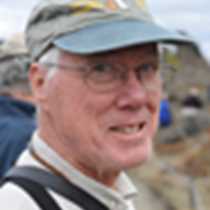Pleneau Island, Port Lockroy & Neko Harbor
After a brilliant night of cruising in Antarctic sea ice admiring the colors of the late-night (and, for some, early-morning) sun, the National Geographic Explorer is working its way northward again. Morning found our ship maneuvering through a field of icebergs as we neared the famous LeMaire Channel from the south. We stopped off of Pleneau Island where we divided our time between walks on the snowy island and Zodiac cruises around the icebergs. The incredible blue colors of the ice are much more vivid under an overcast sky than they are in the brighter light of a clear sky. It was a photographer's delight, with each of us trying to capture in pixels and in memories what the eye saw and the heart felt. A passing snow petrel added a flash of snowy white against the variable hues and textures of icebergs that have calved from the glaciers that surround us.
Ashore we found gentoo penguins just getting started with their summer breeding. Many were standing about waiting for their nest sites to emerge from the snow of winter. Others were stealing stones from their neighbors' nests, even as their own stones were disappearing into yet other nests, and thus the precious stones are redistributed through the colony. A few of the penguins on early-melting sites could be found holding a new egg between their legs. Once a second egg is added to the nest their 33 days of incubation, male and female in alternation, will begin. A leopard seal suddenly appeared by the landing. It was clearly checking us out, and shared a face-to-face greeting with Expedition Leader Lisa Trotter, who just might have been a leopard seal in a former life.
Continuing northward, we passed through the LeMaire to reach our afternoon stop at Port Lockroy. Here British Base A was established in 1944. Later it was used as a research base for the British Antarctic Survey. It has been restored as an Antarctic museum and farthest south gift shop by the U.K. Antarctic Heritage Trust. We gave material support to their efforts to restore and protect historic Antarctic buildings by returning to the ship with bulging shopping bags.
Two landings makes a full day, but three? There we were, close to the Antarctic Continent proper on a clear and calm night, with Mount Française on Anvers Island, the tallest peak in the Peninsula region, visible to the west. Who could resist? Once more to our Zodiacs for an after-dinner landing at Neko Harbor in Anvord Bay. The main attraction, beyond the landing on the Continent itself, was a slow climb up the steep, snowy slope and a much more rapid descent on black garbage bags brought for the occasion or simply on the tails of our blue parkas. A wide variety of landing techniques were in evidence, eliciting applause and sympathetic groans from the onlookers.




